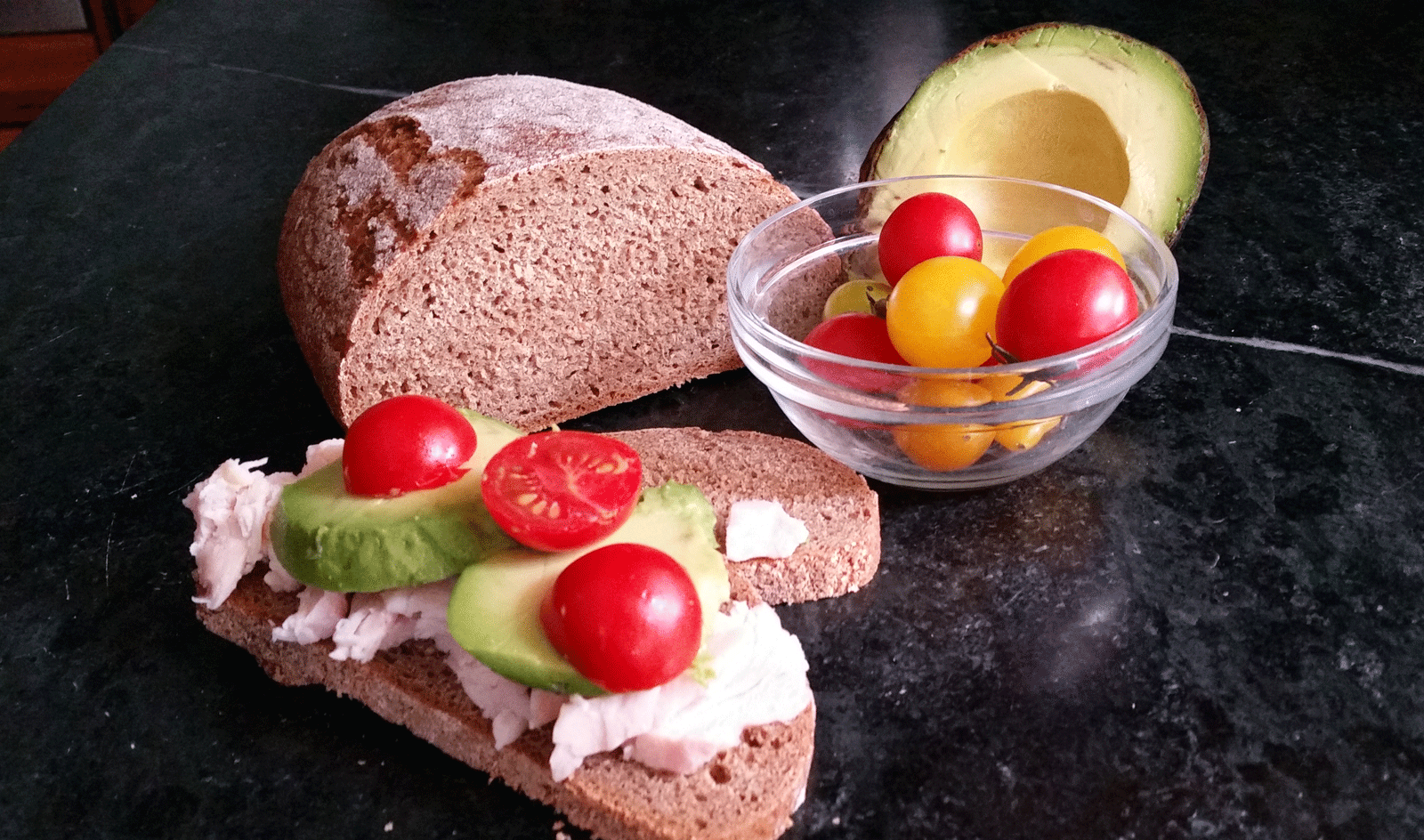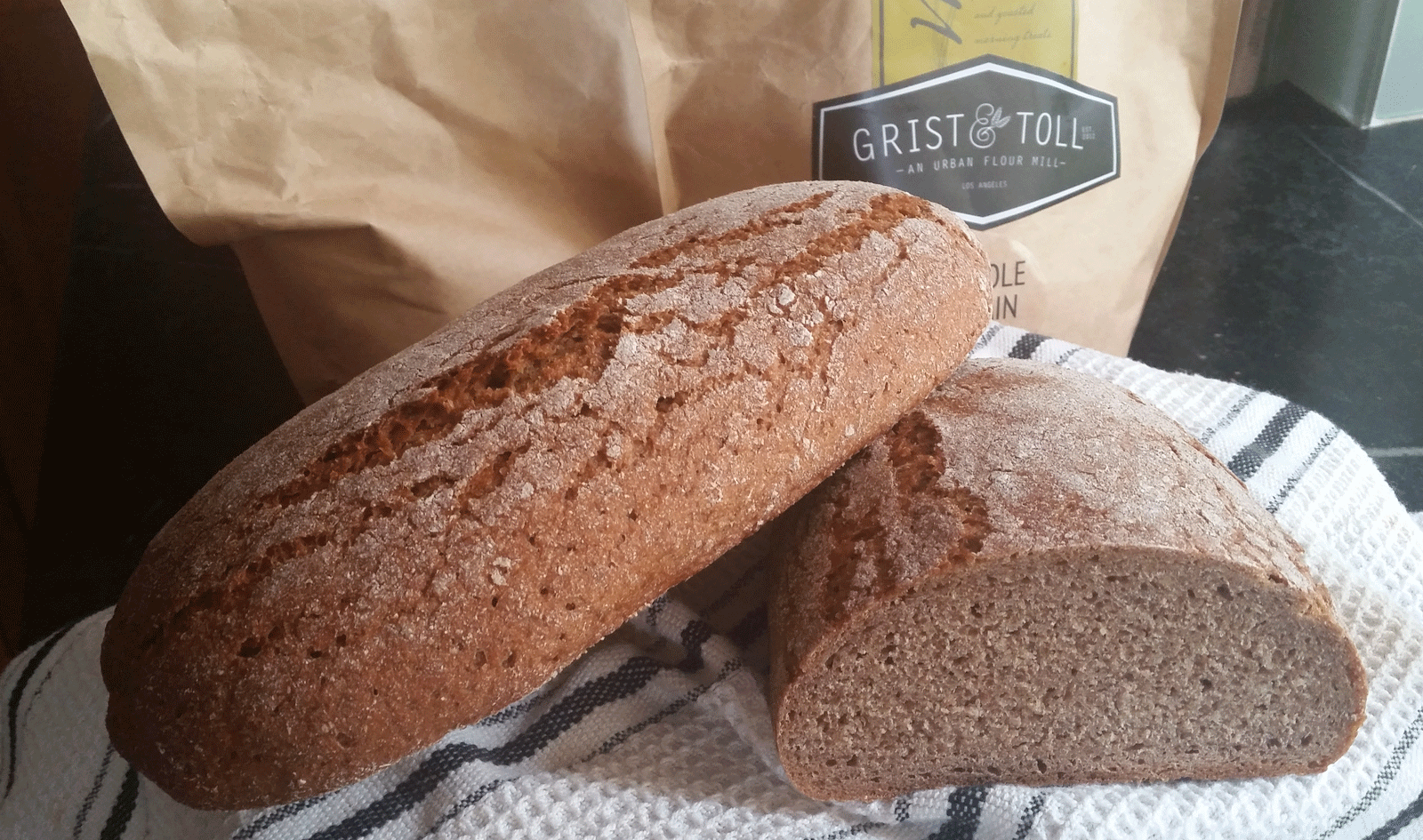| Rye %: | 80% |
| Stages: | 3-Stage sponge, Final dough |
| Leaven: | Rye sour culture |
| Start to Finish: | 20-22 hours |
| Hands-on Time: | 40-50 minutes |
| Yield: | Two 1½ lb./650 g loaves |
Not too long ago I acquired a trove of freshly milled rye and heirloom/heritage wheat flours from Grist & Toll, a groundbreaking urban mill in Pasadena, just north of Los Angeles. After experimenting with the wheat flours, I started casting about for a rye bread that would let me showcase the subtle complexities of the G&T flours. After going through my recipe database, I settled on Franconia Rye/Frankenlaib, a subtle and complex Bavarian bread.
In its standard form – made with light German type 1150 rye flour and first clear flour – Franconia Rye is a typical Alpine rye. Like so many other of the region’s ryes, it’s built on multiple sour sponges (in this case a 3-stage rye sponge), contains a blend of rye and wheat flours and incorporates the sweetness of sugar beet molasses and the understated fragrance of bread spice (brotgewürz), the 10-6-6-2 blend of caraway, anise, fennel and coriander that features widely in German rye baking.
The bread took shape without a hitch. The sponges fermented evenly and retained their structure; the dough was easy to work and the loaves fermented and proofed flawlessly. The result, however, surprised me: instead of an intensely sour bread, which I would have expected from a 3-stage sponge, the interplay of flavors was both subtle and complex. The crumb is close and tender, and the flavor profile features the sweetness of rye, wholegrain wheat and sugar beet molasses, the many-layered notes of the bread spice, and a mild, yet clean and pronounced sour.
This is a bread I love for breakfast, topped with butter, cream cheese or Genoa salami; or for lunch, with roast chicken breast, sliced avocado, summer tomato and a light sprinkling of salt.
Stage 1 Sponge (Day 1, Afternoon):
| Ingredient | Grams | Ounces | Baker’s Percentage |
| Whole rye flour | 70 | 2.45 | 100% |
| Warm (105°F/41°C) water | 70 | 2.45 | 100% |
| Rye sour culture | 15 | 0.55 | 21% |
Combine the Stage 1 sponge ingredients, cover and ferment at room temperature (70°F/21°C) until doubled in volume, about 6 hours.
Stage 2 Sponge (Day 1, Evening):
| Ingredient | Grams | Ounces | Baker’s Percentage |
| Whole rye flour | 75 | 2.65 | 100% |
| Warm (105°F/41°C) water | 75 | 2.65 | 100% |
| Stage 1 sponge | 155 | 5.45 | 207% |
Add the Stage 2 sponge ingredients to the Stage 1 sponge and mix well. Cover and ferment at room temperature overnight, 8-10 hours. The sponge will have doubled in volume and show broken bubbles on the top surface.
Stage 3 Sponge (Day 2, Morning):
| Ingredient | Grams | Ounces | Baker’s Percentage |
| Whole rye flour | 150 | 5.30 | 100% |
| Warm (105°F/41°C) water | 150 | 5.30 | 100% |
| Stage 1 sponge | 305 | 10.75 | 203% |
In the mixer bowl, combine the Stage 3 sponge ingredients and mix until well blended. Cover and ferment at room temperature until doubled in volume and the top surface shows broken bubbles, 2 ½-3 .hours.
Final Dough (Day 2, Midday):
| Ingredient | Grams | Ounces |
| Stage 3 sponge | 605 | 21.35 |
| Whole rye flour | 350 | 12.35 |
| Whole wheat flour | 160 | 5.65 |
| Warm (105°F/41°C) water | 290 | 10.25 |
| Salt | 14 | 0.50 |
| Sugar beet molasses or dark corn syrup | 30 | 1.05 |
| Bread spice | 8 | 0.30 |
Add the final dough ingredients to the Stage 3 sponge.
 Use the dough hook at low (KA2) speed to mix until the dough is fully blended and gathers around the hook, 7-8 minutes.
Use the dough hook at low (KA2) speed to mix until the dough is fully blended and gathers around the hook, 7-8 minutes.
 Use wet hands to smooth the surface of the dough, cover and ferment at room temperature until the dough doubles in volume and shows broken bubbles on the top surface, 45-60 minutes.
Use wet hands to smooth the surface of the dough, cover and ferment at room temperature until the dough doubles in volume and shows broken bubbles on the top surface, 45-60 minutes.
 Turn the dough, which will be firm and slightly sticky, onto a lightly floured work surface. Knead it back to its original volume and divide it into two pieces, each weighing approximately 25 oz./725 g.
Turn the dough, which will be firm and slightly sticky, onto a lightly floured work surface. Knead it back to its original volume and divide it into two pieces, each weighing approximately 25 oz./725 g.
Shape the dough into bâtards or boules, cover and proof at room temperature …
… until the loaves have expanded to 1½ times their original volume and show cracking on the surface.
Preheat the oven to 480°F/250°C with the baking surface in the middle and a steam pan on a lower shelf. Bake with steam for 5 minutes, then remove the steam pan, lower the temperature to 380°F/200°C and bake until the loaves thump when tapped with a finger and the internal temperature is at least 198°F/92°C, 45-50 minutes for bâtards, 50-55 minutes for boules. Transfer to a rack and cool thoroughly before slicing.
Baker’s Percentages:
| Ingredient | g | % |
| TOTAL FLOUR | 805 | 100.00% |
| Whole rye flour | 645 | 80.12% |
| Whole wheat flour | 160 | 19.88% |
| Water | 585 | 72.67% |
| Salt | 14 | 1.74% |
| Rye sour culture | 15 | 1.86% |
| Sugar beet molasses | 30 | 3.73% |
| Bread spice | 8 | 0.99% |
| TOTAL FORMULA | 1,457 | 180.99% |
| Total flour prefermented | 295 | 36.65% |







Sybil
August 3, 2016The bread came out very well. It reminds me of the French rye bread my mother would buy at Christmas to go with smoked salmon when I was young growing up in France. Thinly sliced with butter or cheese, it is delicious. A nice recipe.
Lee
August 25, 2016Stanley, any advice for getting these breads to hold their shape better during baking? I’ve tried several of your recipes using a brotform, and they always flatten out like a pancake.
Part of me is wondering if different rye flours absorb water at different rates?
Following your hydration %’s my dough always seems much looser than described in the recipes.
None of this is a problem if baking in pans, of course!
Stanley Ginsberg
August 25, 2016Definitely sounds like a hydration/absorption issue. Since the flattening appears to be consistent, I suspect it’s the flour (from where?). For starters, I’d reduce the hydration by 5% and see if that makes a difference; if not, you may want to take it down another 5%. This is where the science of baking becomes art!!!!
Lee
August 26, 2016The flour’s locally grown here in Ontario, I buy it in buckets and mill it fresh, I have some aging at the moment so I will see if aged makes a difference.
We live in a high humidity area here in the summer, I’ve been thinking that might be a factor.
My last bake was Austrian country rye, it flattened out with 1/2 fresh rye and 1/2 aged, the crumb looks much more open than yours, almost like high hydration ciabatta.
But apart from the shape, its always excellent tasting bread!
sean
April 2, 2019approximately how long does the final proof (shaped and waiting to go into the oven) take?
Stanley Ginsberg
April 12, 2019Time varies with room temperature and maturity of the dough. Look for cracks or broken bubbles on the surface of the loaf.
sean
April 15, 2019I did wait until I saw cracks along the loaf, but the crumb was more dense than your loaves. I suspect my dough was a bit too dry.
Still tasted great though!